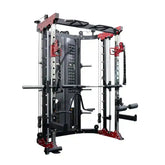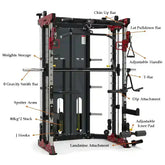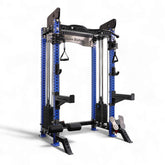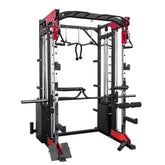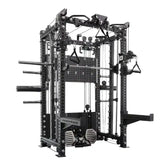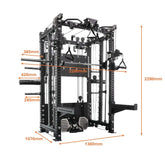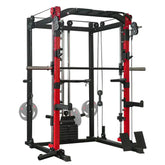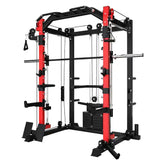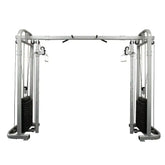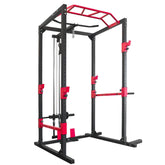Home Gym Dumbbell Set: Build Strength Without Leaving the House
A home gym dumbbell set transforms any space into a powerful training zone. With proper technique, smart progression, and the right mindset, you can build real muscle, burn fat, and maintain discipline — no commercial gym required.
When I was competing, my training days revolved around gym hours, equipment availability, and the sound of metal hitting metal. These days, I train differently — not because I’ve lost passion, but because I’ve gained perspective.
After ten years of training clients and athletes, I’ve learned that you don’t need a fancy gym to build a strong, aesthetic physique. What you need is focus, knowledge, and a solid home gym dumbbell set.
Let me show you how to turn your space into a results-driven training environment — the same way I coach my clients, from bodybuilders to busy parents who just want to feel strong again.
Why Every Home Gym Starts with Dumbbells
Whenever someone asks me how to start building a home gym, my answer is simple: start with dumbbells — they’re the foundation of any great training setup.

Dumbbells do more than just build muscle. They build control, stability, and body awareness — qualities that benefit every athlete, from beginners to seasoned lifters.
Here’s why every home gym should include a quality dumbbell set:
-
Space-Efficient: You can train your entire body in a small corner of your house.
-
Versatile: From strength and power movements to mobility and rehab exercises, dumbbells adapt to your goals.
-
Joint-Friendly: Their natural range of motion helps protect your joints and prevent overuse injuries.
-
Scalable: With adjustable dumbbells, one compact set replaces multiple fixed weights and grows with your strength.
To complete your setup, pair your adjustable dumbbells with an adjustable bench and a squat rack — this combination forms the foundation for 90% of effective strength training routines. When you’re ready to expand, cable machine to create a fully functional, space-efficient gym that supports real muscle growth, power, and performance — all from the comfort of home.
How to Train Every Muscle Group with Dumbbells
When I design home training programs for my clients, I focus on function and flow — not random workouts. Each dumbbell movement should teach your body to move better, stronger, and with purpose.

Legs: The Foundation of Power
Even without machines, dumbbells can build thick, powerful legs when used with the right form and intensity.
Exercises I Recommend:
-
Goblet Squat: 4 × 12 — keeps your spine safe and core tight.
-
Dumbbell Step-Up: 3 × 10 per leg — develops unilateral strength and balance.
-
Romanian Deadlift (RDL): 4 × 8 — stretches and strengthens your hamstrings and glutes.
If you want to take lower-body training further, combine your dumbbell work with a squat rack or leg press machine for added resistance and stability.
Chest: Shape and Strength
Dumbbells outperform barbells when it comes to chest development because they allow a full, natural range of motion.
Go-To Movements:
-
Flat Dumbbell Press: 4 × 10 — builds mid-chest thickness.
-
Incline Press: 4 × 8 — targets the upper chest and shoulders.
-
Dumbbell Fly: 3 × 12 — stretches and isolates the pecs deeply.
Perform these on an adjustable bench and control each rep — especially on the way down.
Coach’s Tip: The slower your eccentric (lowering) phase, the faster your chest grows.
Back: The Engine of Athleticism
You don’t need cables or machines to develop a strong, defined back — dumbbells can get the job done.
Back Builders:
-
Single-Arm Dumbbell Row: 4 × 12 — squeeze your lats at the top of each rep.
-
Dumbbell Deadlift: 4 × 10 — a full-body strength builder for traps, glutes, and hamstrings.
-
Reverse Fly: 3 × 15 — isolates your rear delts and rhomboids for posture and balance.
If you have a cable machine, pair these with seated rows or face pulls to add variety and constant tension.
Shoulders: Definition and Stability
A well-built shoulder cap transforms your physique. Dumbbells help you create the round, aesthetic definition bodybuilders are known for.
Try this Tri-Set:
-
Seated Shoulder Press: 4 × 10
-
Lateral Raise: 3 × 15
-
Rear Delt Fly: 3 × 15
Keep rest minimal between sets to maximise muscle recruitment.
Tip: Maintain soft elbows and controlled motion to protect your joints.
Arms: Balanced Strength and Symmetry
Biceps and triceps may be small, but they define proportion and strength.
Dumbbell Finishers I Recommend:
-
Bicep Curl Variations: Supinated, hammer, or alternating curls for full-arm development.
-
Overhead Tricep Extensions: Great for long-head tricep activation.
-
Close-Grip Dumbbell Press: Builds triceps and chest simultaneously.
Want to focus on detail work? Check out our blog post about building a defined chest and strong shoulders using dumbbells for more technique tips and advanced training volume.
How I Coach Progressive Overload at Home
Without access to big commercial machines, you can’t “just add a plate” — but that’s not a limitation. It’s an opportunity to train smarter.
Here’s how I coach progressive overload using a home gym dumbbell set:
-
Increase reps before increasing weight — master control first.
-
Slow your tempo: 3 seconds down, 1 second up.
-
Add pauses at the hardest point of the lift for greater tension.
-
Reduce rest times slightly to raise intensity and endurance.
These small progressions lead to massive results over time — all possible with a pair of adjustable dumbbells and consistency.
Nutrition: The Other Half of Strength
The truth? You can’t out-train a poor diet.
Here’s the simple, proven nutrition strategy I recommend for home-based athletes:
Pre-Workout (Fuel):
-
Oats, banana, peanut butter, and black coffee for steady energy.
Post-Workout (Recovery):
-
Whey protein shake + rice cakes or fruit to replenish glycogen and aid muscle repair.
Main Meals (Build):
-
Lean protein: chicken, fish, or tofu.
-
Complex carbs: sweet potatoes, brown rice, oats.
-
Healthy fats: avocado, olive oil, nuts.
And don’t forget hydration — it’s the most underrated recovery tool. Aim for at least 3 litres of water per day, adding electrolytes after intense sessions.
Coach’s Insight: Performance comes from consistency, not restriction.
Train smart, eat balanced, and your body will reward you with strength that lasts.
The Mental Edge of Home Training
Training at home isn’t just physical — it’s mental. There’s no crowd, no noise, and no one watching. You train because you said you would. That’s how discipline is built.
Over time, that same discipline carries into every area of your life — your nutrition, sleep, and mindset. That’s why I tell my clients:
“If you can master consistency in your home gym, you can master it anywhere.”
Your setup might be simple, but your results won’t be.
Quick Tips to Maximise Home Workouts
-
Train at the same time daily — routine builds results.
-
Track every workout — progressive overload needs proof.
-
Keep your space clean and inviting — environment affects effort.
-
Add motivational cues — mirrors, music, and lighting matter more than you think.
-
Upgrade slowly — start with dumbbells and benches, then expand when you’ve earned it.
Final Thoughts: Build Strength, Build Freedom
Your home gym dumbbell set isn’t just equipment — it’s empowerment.
It gives you ownership of your progress and eliminates excuses.
You don’t need a commercial gym to build an athlete’s body — just focus, smart training, and consistency. As a coach, I’ve seen transformations happen in garages, bedrooms, and balconies — proof that the environment doesn’t define your results, your discipline does.
Your home can become that place — where effort meets freedom and progress becomes lifestyle.
Explore the Home Gym Collection at Alpha Go Fitness or contact us now! Start building your space, build your strength, and start your transformation today.
Frequently Asked Questions
Can I build serious muscle with a home gym dumbbell set?
Absolutely. With proper progressive overload, smart nutrition, and recovery, dumbbells can rival — and sometimes outperform — machines. Many athletes and bodybuilders (myself included) have built competition-level physiques with nothing more than adjustable dumbbells and consistent effort.
What’s the best dumbbell setup for beginners?
Start with adjustable dumbbells — they’re compact, space-saving, and replace an entire rack of fixed weights.
How can I make my home gym more versatile?
Pair your dumbbells with an adjustable bench and a cable machine for more exercise variety and smooth progression. This combination supports both strength and functional training in a compact space.
How much space do I need for a compact gym?
Around 2×2 meters is plenty — enough room for a bench, dumbbells, and free movement.
For limited spaces like apartments or garages, check out Alpha Go Fitness’s Home Gym Collection for compact, modular setups.
Can I train every day at home?
You can — but avoid training the same muscle group daily. Rotate between upper, lower, and full-body sessions, and include at least one full rest day per week to promote muscle repair and growth.

